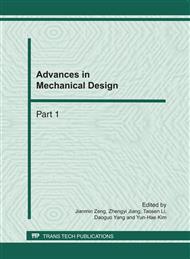[1]
J.F.W. Herschel, On the absorption of light by coloured media, viewed in connection with the undulatory theory, Philos. Mag. 3, 401-412, 1833.
Google Scholar
[2]
G. Quincke, Über Interferenzapparate für Schallwellen, (On an interference device for sound waves), Ann. Phys. Chem. 128, 177–192, 1866.
DOI: 10.1002/andp.18662040602
Google Scholar
[3]
A. Selamet, N.S. Dickey, and J.M. Novak, The Herschel-Quincke tube: A theoretical, computational and experimental investigation, J. Acoust. Soc. Am. 96, 3177–3185, (1994).
DOI: 10.1121/1.411255
Google Scholar
[4]
A. Selamet and V. Easwaran, Modified Herschel-Quincke tube: Attenuation and resonance for n-duct configuration, J. Acoust. Soc. Am. 102, 164–169, (1997).
DOI: 10.1121/1.419775
Google Scholar
[5]
A.J. Torregrosa, A. Broatch, and R. Payri, A study of the influence of mean flow on the acoustic performance of Herschel-Quincke tubes, J. Acoust. Soc. Am. 107, 1874–1879, (2000).
DOI: 10.1121/1.428468
Google Scholar
[6]
Z. Zhichi, L. Song, T. Rui, G. Rui, D. Genhua, and L. Peizi, Application of Quincke tubes to flow ducts as a sound attenuation device, Noise Control Eng. J. 46, 245–255, (1998).
DOI: 10.3397/1.2828476
Google Scholar
[7]
C.R. Fuller and D.A. Bies, The effects of flow on the performance of a reactive acoustic attenuator, J. Sound Vib. 62, 73–92, (1979).
DOI: 10.1016/0022-460x(79)90558-3
Google Scholar
[8]
K. Mikael, and G. ragnar, The Herschel–Quincke tube: The attenuation conditions and their sensitivity to mean flow, Acoustical Society of America. 124(2), 723–732, (2008).
DOI: 10.1121/1.2940580
Google Scholar
[9]
Y. Hwang, J.M. Lee, and S. -J. Kim, New active muffler system utilizing destructive interference by difference of transmission paths, J. Sound Vib. 262, 175–186, (2003).
DOI: 10.1016/s0022-460x(02)01378-0
Google Scholar
[10]
J. M. Desantes, A.J. Torregrosa, H. Climent, and D. Moya, Acoustic performance of Herschel-Quincke tube modified with an interconnecting pipe, J. Sound Vib. 284, 283–298, (2005).
DOI: 10.1016/j.jsv.2004.06.016
Google Scholar
[11]
E. P. Trochon, A new type of silencer for turbocharger noise control, SAE Conference on Noise and Vibration Control, Traverse City, MI, April 2001, 2001-01-1436.
DOI: 10.4271/2001-01-1436
Google Scholar
[12]
I. McLean, Optimized Herschel-Quincke acoustic filter, SAE Conference on Noise and Vibration, Traverse City, MI, May 2005, 2005-01-2360.
DOI: 10.4271/2005-01-2360
Google Scholar
[13]
R.A. Burdisso and J.P. Smith, Control of inlet noise from turbofan engines using Herschel-Quincke waveguides, 21st AIAA Aeroacoustics Conference, Lahaina, HI, 12-14 June 2000, AIAA-2000-(1994).
DOI: 10.2514/6.2000-1994
Google Scholar
[14]
M.J. Michael, Fundamental Studies of the Herschel-Quincke Tube Concept with Mode Measurements, MS Thesis, State University, Virginia, American, (2005).
Google Scholar
[15]
M. L. Munjal, Acoustics of Ducts and Mufflers, Wiley, New York, (1987).
Google Scholar


